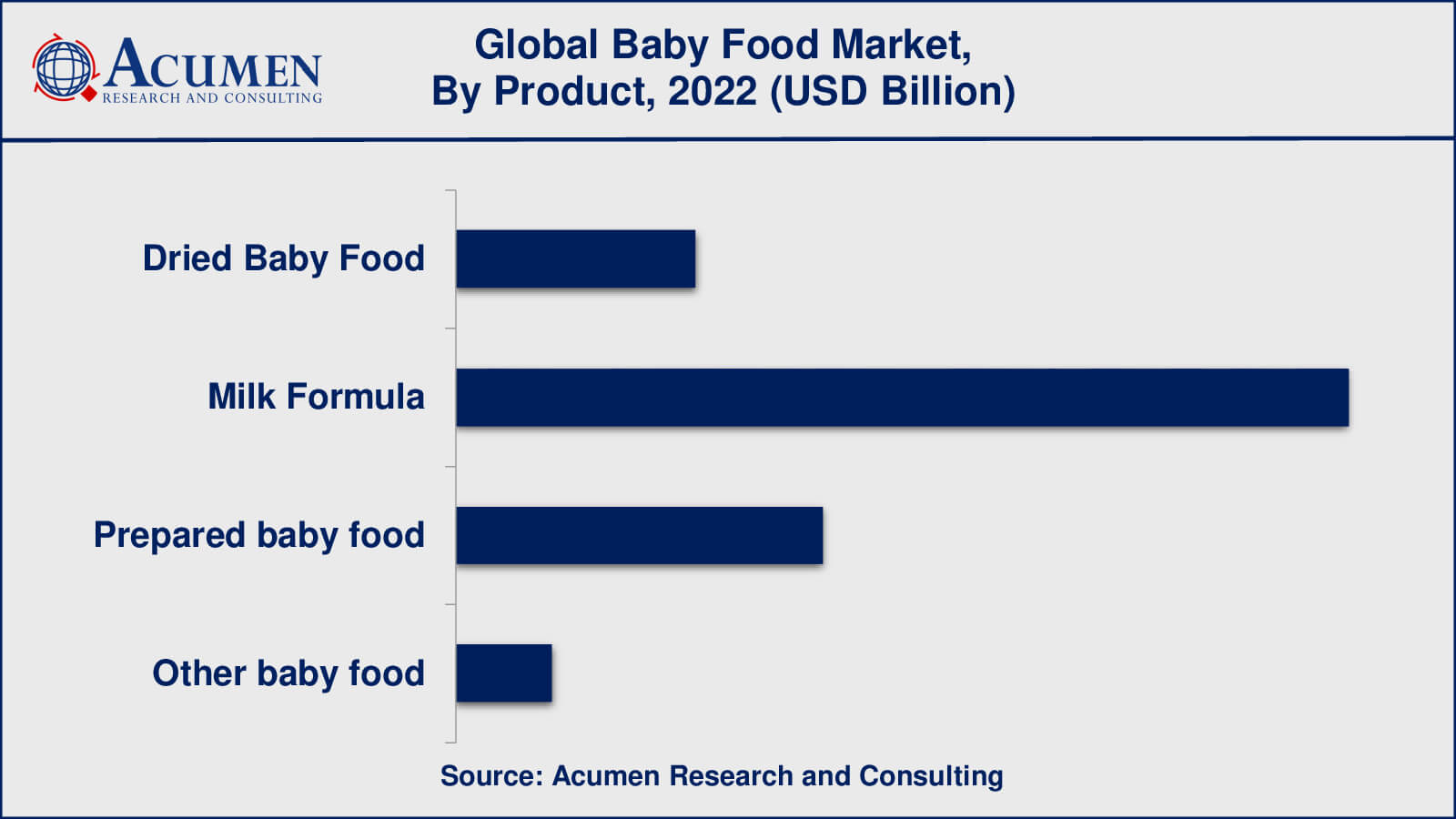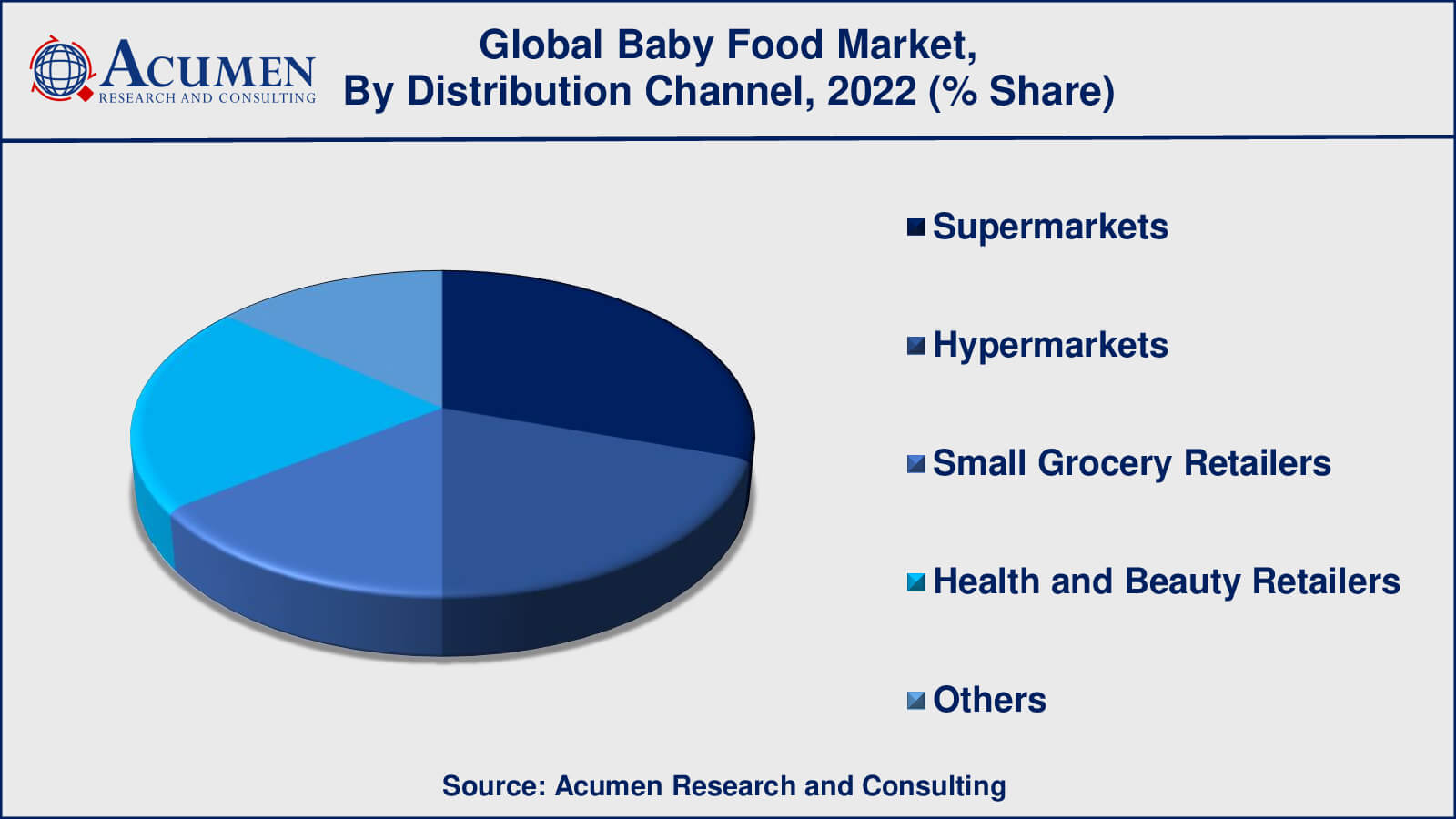Baby Food Market Size - Global Industry, Share, Analysis, Trends and Forecast 2023 - 2032
Published :
Report ID:
Pages :
Format :
Baby Food Market Size - Global Industry, Share, Analysis, Trends and Forecast 2023 - 2032
Report Coverage
- Industry Dynamics
- Market Size and Forecast Data
- Segment Analysis
- Competitive Landscape
- Regional Analysis with a Niche Focus on Country-Level Data
- High Level Analysis - Porter's, PESTEL, Value Chain, etc.
- Company Profiles of Key Players
- Option to Customize the Report As Per Your Specific Need
Request Sample Report
The Baby Food Market Size collected USD 81.6 Billion in 2022 and is set to achieve a market size of USD 131.6 Billion in 2032 growing at a CAGR of 4.5% from 2023 to 2032.
Baby Food Market Report Statistics
- Global baby food market revenue is estimated to reach USD 131.6 billion by 2032 with a CAGR of 4.5% from 2023 to 2032
- Asia-Pacific baby food market value occupied more than USD 28 billion in 2022
- MEA baby food market growth will record a CAGR of around 4% from 2023 to 2032
- Among product, the milk formula sub-segment generated more than 55% share in 2022
- Based on distribution channel, the plastic generated more than US $ 24.5 billion revenue in 2022
- Rising adoption of organic and natural baby food is a popular baby food market trend that fuels the industry demand

The demand for baby food is witnessing a major surge due to an increase in parental concerns about nutrition. Baby food is soft in nature and specifically targeted toward infants between six months to two years of age. These are available in multiple varieties, forms, and tastes. Baby food is inclusive of food that has been mashed or made easily available and can be purchased from retail shops. The rising number of working women is the major factor driving the demand for baby food, thus creating an opportunity for manufacturers. Further, professionally made baby food is a perfect solution for breastfeeding problems. Owing to the need to fulfilling the nutrition requirements of babies, such baby food helps to prevent the under-nutrition problem in babies.

Global Baby Food Market Dynamics
Market Drivers
- Growing demand for convenient and healthy baby food
- Increasing urbanization and changing lifestyles
- Rising awareness about the benefits of breastfeeding
- Increased focus on traceability and transparency
Market Restraints
- Environmental concerns associated with plastic packaging
- Food safety and regulatory compliance
- Competition from alternative packaging solutions
Market Opportunities
- Technological advancements in the production of baby food
- Increased marketing and promotional activities by manufacturers
Baby Food Market Report Coverage
| Market | Baby Food Market |
| Baby Food Market Size 2022 | USD 81.6 Billion |
| Baby Food Market Forecast 2032 | USD 131.6 Billion |
| Baby Food Market CAGR During 2023 - 2032 | 4.5% |
| Baby Food Market Analysis Period | 2020 - 2032 |
| Baby Food Market Base Year | 2022 |
| Baby Food Market Forecast Data | 2023 - 2032 |
| Segments Covered | By Product, By Category, By Distribution Channel, And By Geography |
| Regional Scope | North America, Europe, Asia Pacific, Latin America, and Middle East & Africa |
| Key Companies Profiled | Abbott Laboratories, Bellamy’s Organic Pty Ltd., Bledina S.A., Campbell Soup Company., Groupe Danone, Mead Johnson & Company, LLC., Nestle S.A., Perrigo Company Plc, Royal Frieslandcampina N.V., and The Hain Celestial Group, Inc. |
| Report Coverage |
Market Trends, Drivers, Restraints, Competitive Analysis, Player Profiling, Covid-19 Analysis, Regulation Analysis |
Baby Food Market Growth Factors
The adoption of a modern lifestyle in developing nations is resulting in an increasing population of working women, thus fueling the demand for the baby food market. This is mainly influenced by western culture in terms of lifestyle and feeding habits among others. This factor is also backed by the increasing disposable income of consumers that has led them to provide a healthy lifestyle for their babies. The high birth rate in North African and Middle Eastern countries is also driving the growth of this industry. Asia-Pacific is also a lucrative region for the growth of the baby food market and owing to its highly lucrative nature, major manufacturers are looking to penetrate this region for expansion opportunities.
However, the market is held back by the declining birth rates in developed countries. This factor is greatly barring the growth of the baby food market at present. Further, lactose intolerant babies are another restraining factor for the global baby food market. However, product development through extensive research and development activities is a suitable growth opportunity for this market. Further, aggressive marketing and promotional activities adopted by these players would also ensure the proper growth of this industry in the future.
Baby Food Market Segmentation
The worldwide baby food market is categorized based on product, category, distribution channel, and geography.
Baby Food Market By Product
- Dried Baby Food
- Milk Formula
- Prepared Baby Food
- Other Products

According to the baby food market forecast, milk formula is the product type that will dominate the baby food market in the coming future. Milk formula is a powdered as well as liquid form of infant formula that contains all of the nutrients required for an infant's development and growth. It is typically made from cow's milk and fortified with minerals and vitamins to meet infant nutritional needs. Milk formula is widely used by families who are unable or unwilling to breastfeed their babies, and it comes in a variety of formulations to meet a variety of needs and preferences. Milk formula accounts for a sizable portion of the global baby food market and is expected to remain dominant in the coming years.
Baby Food Market By Category
- Organic
- Conventional
Organic baby food is becoming increasingly popular and is expected to continue to dominate the baby food market. Organic baby food is made from ingredients that have not been treated with synthetic fertilizers, pesticides, or other chemicals. These products are perceived to be healthier and safer for babies, and are increasingly preferred by parents concerned about the quality and safety of the food they feed their infants. Organic baby food is also thought to be more beneficial to the environment than conventional baby food. As a result, demand for organic baby food is increasing, and manufacturers are responding by increasing organic baby food production. While conventional baby food continues to hold a sizable market share, the trend toward organic baby food is expected to continue in the coming years.
Baby Food Market By Distribution Channel
- Supermarkets
- Hypermarkets
- Small Grocery Retailers
- Health and Beauty Retailers
- Others

According to a baby food industry analysis, the distribution channels that dominate the baby food market are supermarkets and hypermarkets. These large retailers stock a wide variety of baby food products from a variety of manufacturers, making it simple for parents to find and purchase the items they require. Supermarkets and hypermarkets also have competitive pricing and promotions, which can help drive baby food sales. Furthermore, these retailers frequently have a strong presence in cities, where many parents live and shop. While small grocery stores, health and beauty stores, and other distribution channels are important in the baby food market, supermarkets and hypermarkets are the primary distribution channels for baby food products.
Baby Food Market Regional Outlook
North America
- U.S.
- Canada
Europe
- U.K.
- Germany
- France
- Spain
- Rest of Europe
Asia-Pacific
- India
- Japan
- China
- Australia
- South Korea
- Rest of Asia-Pacific
Latin America
- Brazil
- Mexico
- Rest of Latin America
The Middle East & Africa
- South Africa
- GCC Countries
- Rest of the Middle East & Africa (ME&A)
Baby Food Market Regional Analysis
The Asia-Pacific region has recently captured the largest share of the baby food market. This is due to a variety of factors, including rising disposable income and increased parental awareness of the importance of providing high-quality nutrition for their infants. Furthermore, many Asia-Pacific countries are experiencing rapid economic growth, which is provoking demand for baby food products. China and India are the region's two largest baby food markets, followed by Japan, South Korea, and Australia. Because of population growth and rising consumer demand, the Asia-Pacific region is expected to maintain its lead in the baby food market in the coming years.
The Middle East and Africa region has recently been the fastest growing region in the baby food market. This is due to a variety of factors, including rising birth rates, rising disposable income, and increased urbanization in the region. Furthermore, parents are becoming more aware of the importance of providing high-quality nutrition for their infants, which is pushing demand for baby food products. Many Middle Eastern and African nations are experiencing rapid economic development and urbanization, which is changing consumer behavior and increasing demand for convenience products. Saudi Arabia, the United Arab Emirates, South Africa, Egypt, and Morocco are the region's major markets for baby food.
Baby Food Market Players
Some of the global baby food companies profiled in the report include Abbott Laboratories, Bellamy’s Organic Pty Ltd., Bledina S.A., Campbell Soup Company., Groupe Danone, Mead Johnson & Company, LLC., Nestle S.A., Perrigo Company Plc, Royal Frieslandcampina N.V., and The Hain Celestial Group, Inc.
Frequently Asked Questions
What was the market size of the global baby food in 2022?
The market size of baby food was USD 81.6 Billion in 2022.
What is the CAGR of the global baby food market during forecast period of 2023 to 2032?
The CAGR of baby food market is 4.5% during the analysis period of 2023 to 2032.
Which are the key players operating in the market?
The key players operating in the global market are Abbott Laboratories, Bellamy�s Organic Pty Ltd., Bledina S.A., Campbell Soup Company., Groupe Danone, Mead Johnson & Company, LLC., Nestle S.A., Perrigo Company Plc, Royal Frieslandcampina N.V., and The Hain Celestial Group, Inc.
Which region held the dominating position in the global baby food market?
North America held the dominating position in baby food market during the analysis period of 2023 to 2032.
Which region registered the fastest growing CAGR for the forecast period of 2023 to 2032?
Asia-Pacific region exhibited fastest growing CAGR for baby food market during the analysis period of 2023 to 2032.
What are the current trends and dynamics in the global baby food market?
The current trends and dynamics in the baby food industry include growing demand for convenient and healthy baby food, increasing urbanization and changing lifestyles, and rising awareness about the benefits of breastfeeding.
Which product held the maximum share in 2022?
The milk formula product held the maximum share of the baby food market.



